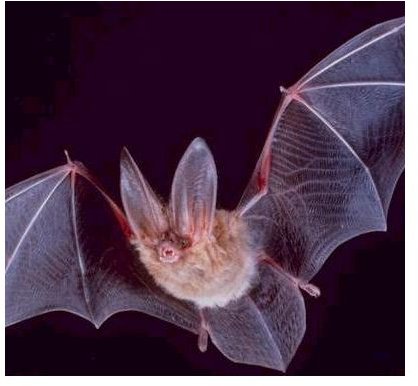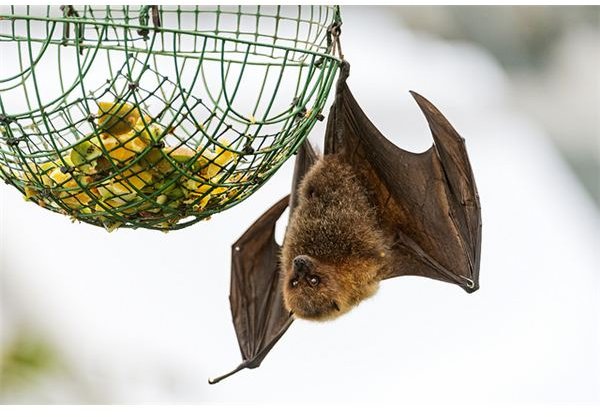Learn about Bats: What They Look Like, What They Eat, Where They Live and Stories They Have Inspired
If you were a teenage bat, you would hang around by your thumbs or upside-down by your toenails, and it might not seem possible, but you could relax those toes while clutching your roosting spot. You would stay up all night and could fly through dense woods, dark caves or rain forests without bumping into anything. You would probably have a furry head and huge eyes to help you see far distances and in the dark.
Fear, Supernatural and Loathing
Bats have long been associated with creatures of the night such as the supernatural beings that could unleash otherworldly powers. Many cultures have stories about bats, but the history of bats in ancient Rome says that bats are nurturing. In the poem Metamorphoses, the writer Ovid says the daughters of Minyas were insubordinate to their Greek leader and to teach them a lesson, he turned them into bats so they would always be under the care of their father.
The Mayans of Central America have an ancient book, Popol Vuh, that tells the story of bat-like monsters that try to kill heroic twin brothers who are on an incredible journey. There are also bats depicted in pre-Hispanic art. These bats are known as “zotz” in several Maya languages and associated the deities of death and night. They are often depicted in sculptures and were thought to be inhabitants of the underworld, as that is what caves meant to these people and many bats live in caves.
Of course, we know that Bram Stocker’s 1897 novel, Dracula, had the lead character the vampire Count Dracula, who could transform himself into a bat. Can you think of a better creature to navigate the night?
Winged Mammals

There are a 1,000 species of bats in the world—including the micro, tiny and mega, large bats—but they are the only flying mammals. Mammals are warm-blooded creatures who nurse their young, just as humans do.
Bats are in an Order called Chiroptera, which means “hard wing,” and those wings are amazing.
Two layers of skin wrap a bat’s four long finger bones to make a wing. An almost total flying machine, the bat’s wing runs the entire length of the bat’s body and attaches to his hind leg. There is a tail attached on some species; three species of mouse-tailed bat have tails as long as their body and head put together, but most bats’ tails are short.
As you would think, the bat’s chest and shoulders are super strong to support the act of flying (and they make it look effortless)—you could call them the acrobats of the air. They can snatch a mosquito with their mouth or use their wing like, what author Laurence Pringle calls, “… a baseball player’s glove to snag a bug and then bring the insect to its mouth.”
All bats have soft furry bodies (of various hue) and membrane-stretched wings; their claws allow them to cling almost anywhere.
Size is Relative
The smallest bat in the world is the Philippine bamboo is, also called the “bumblebee” because it is only 1.5-inches or 3.8 cm long and weighing in at just one ounce. On the other end of the spectrum, the world’s largest bat is the giant golden-crowned flying fox or golden-capped fruit bat as it is sometimes called, at up to three pounds (1.4 kgwith a wingspan of more than five feet (1.5 m).
A Face for Feasting
The shape of a bat’s head suits its dietary food habits. They can be nectar feeding (plants), insectivorous (eats insects), frugivorous (eats fruits), carnivorous (flesh eating), omnivorous (wide-ranging foods) and hematophagous (feeding on blood). The fruit bat, for example, has a long snout and a long tongue to sip nectar and eat fruits.
Some bats catch frogs, small birds or mice, but the vampire bat of Central and South America can take a little bite on a cow, for instance, and lick up the blood. Substances such as a natural anticoagulant in the bat’s saliva keeps the cow’s blood flowing. Since blood is quite diluted, the bat needs large amounts for its size in order to reap nutritional benefits. Consequently, vampire bats’ stomachs and kidneys rapidly separate the water from the rest of the blood and the bats can become engorged and unable to fly.
Weighing just one or two ounces, this tiny bat does not hurt the victim. One ounce of blood is usually enough for two or three days. In addition, the bat will share this meal with a sick or hungry member of its colony. The downside is this makes them susceptible to blood-borne diseases such as rabies—an infectious disease that affects the central nervous system—that can be passed on to other animals and humans and can be fatal, although they very rarely attack humans.
Echolocation
Similar to dolphins that make use of sonar, bats use echolocation. They send signals out—often too high-pitched for human ears—and the bounce back allows them to detect the location and size of objects around them. No matter whether it is a mountain or a mosquito, the bat’s ability is precise: 1,000 times more powerful than similar human technology.
Did you know?
Bats have nurseries. An area filled with thousands of bats and bat babies. When the mother returns with food, amazingly she can always find her young.
Bats who eat pollen are important pollinators and seed spreaders; experts believe that 95 percent regrowth in rainforests is due to bat droppings.
Bats are fragile; one quarter of the world’s bat species are listed as threatened or endangered according to the Red List published by the International Union for Conservation of Nature (IUCN).
References
- ASU Ask a Biologist: Echolocation
- “Square-townsend-fledermaus” by Original uploader was Velho at en.wikipedia
- Gish, Melissa. Bats. Mankato, Minnesota: Creative Paperbacks, 2011. Book.
- Bat Conservation International
- Image Source: Fruit Bat and Food - flickr.com/tambako
- Pringle, Laurence. Bats! Strange and Wonderful. Honesdale, PA: Caroline House, Boyds Mills Press Inc., 2000. Book.
- UCMP: Chiroptera
